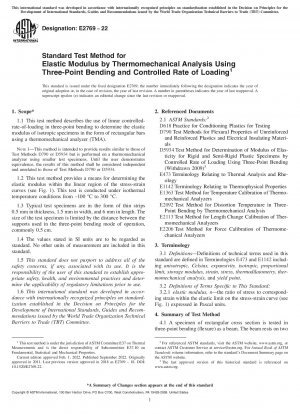ASTM E2769-22
Standard Test Method for Elastic Modulus by Thermomechanical Analysis Using Three-Point Bending and Controlled Rate of Loading
- Standard No.
- ASTM E2769-22
- Release Date
- 2022
- Published By
- American Society for Testing and Materials (ASTM)
- Latest
- ASTM E2769-22
- Scope
- 1.1 This test method describes the use of linear controlledrate-of-loading in three-point bending to determine the elastic modulus of isotropic specimens in the form of rectangular bars using a thermomechanical analyzer (TMA). NOTE 1—This method is intended to provide results similar to those of Test Methods D790 or D5934 but is performed on a thermomechanical analyzer using smaller test specimens. Until the user demonstrates equivalence, the results of this method shall be considered independent and unrelated to those of Test Methods D790 or D5934. 1.2 This test method provides a means for determining the elastic modulus within the linear region of the stress-strain curves (see Fig. 1). This test is conducted under isothermal temperature conditions from –100 °C to 300 °C. 1.3 Typical test specimens are in the form of thin strips 0.5 mm in thickness, 1.5 mm in width, and 6 mm in length. The size of the test specimen is limited by the distance between the supports used in the three-point bending mode of operation, commonly 0.5 cm. 1.4 The values stated in SI units are to be regarded as standard. No other units of measurement are included in this standard. 1.5 This standard does not purport to address all of the safety concerns, if any, associated with its use. It is the responsibility of the user of this standard to establish appropriate safety, health, and environmental practices and determine the applicability of regulatory limitations prior to use. 1.6 This international standard was developed in accordance with internationally recognized principles on standardization established in the Decision on Principles for the Development of International Standards, Guides and Recommendations issued by the World Trade Organization Technical Barriers to Trade (TBT) Committee.
ASTM E2769-22 Referenced Document
- ASTM D5934 Standard Test Method for Determination of Modulus of Elasticity for Rigid and Semi-Rigid Plastic Specimens by Controlled Rate of Loading Using Three-Point Bending
- ASTM D618 Standard Practice for Conditioning Plastics for Testing
- ASTM D790 Standard Test Methods for Flexural Properties of Unreinforced and Reinforced Plastics and Electrical Insulating Materials*, 2024-04-20 Update
- ASTM E1142 Standard Terminology Relating to Thermophysical Properties
- ASTM E1363 Standard Test Method for Temperature Calibration of Thermomechanical Analyzers
- ASTM E2092 Standard Test Method for Distortion Temperature in Three-Point Bending by Thermomechanical Analysis*, 2023-11-01 Update
- ASTM E2113 Standard Test Method for Length Change Calibration of Thermomechanical Analyzers*, 2023-08-01 Update
- ASTM E2206 Standard Test Method for Force Calibration of Thermomechanical Analyzers
- ASTM E473 Standard Terminology Relating to Thermal Analysis
ASTM E2769-22 history
- 2022 ASTM E2769-22 Standard Test Method for Elastic Modulus by Thermomechanical Analysis Using Three-Point Bending and Controlled Rate of Loading
- 2018 ASTM E2769-18 Standard Test Method for Elastic Modulus by Thermomechanical Analysis Using Three-Point Bending and Controlled Rate of Loading
- 2016 ASTM E2769-16 Standard Test Method for Elastic Modulus by Thermomechanical Analysis Using Three-Point Bending and Controlled Rate of Loading
- 2015 ASTM E2769-15 Standard Test Method for Elastic Modulus by Thermomechanical Analysis Using Three-Point Bending and Controlled Rate of Loading
- 2013 ASTM E2769-13 Standard Test Method for Elastic Modulus by Thermomechanical Analysis Using Three-Point Bending and Controlled Rate of Loading
- 2011 ASTM E2769-11 Standard Test Method for Elastic Modulus by Thermomechanical Analysis Using Three-Point Bending and Controlled Rate of Loading
